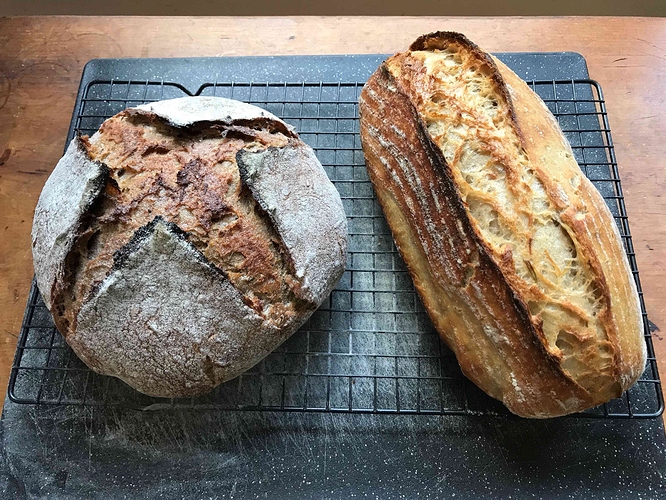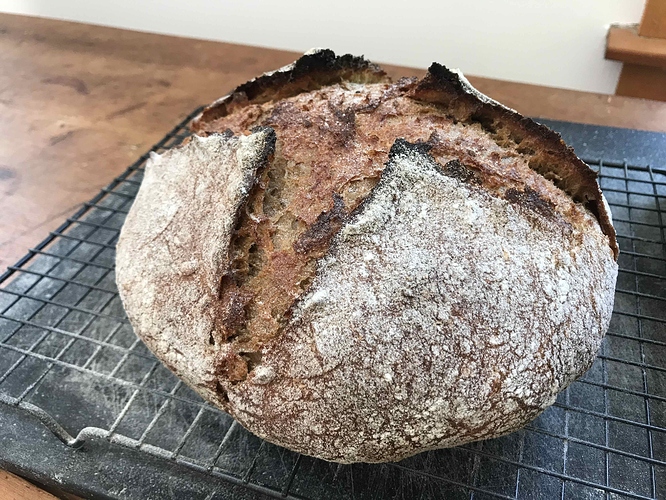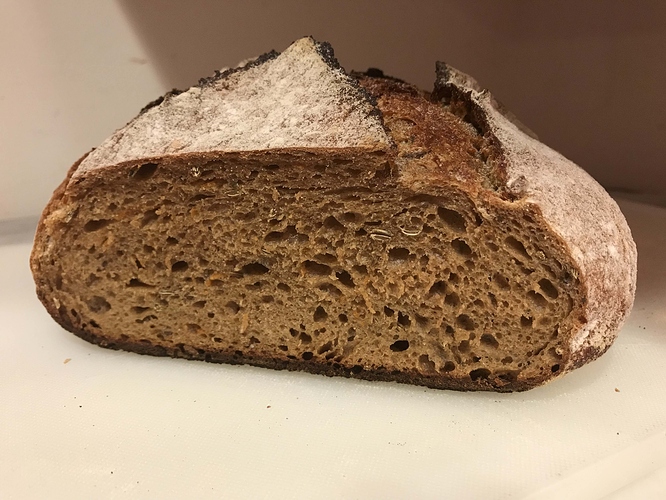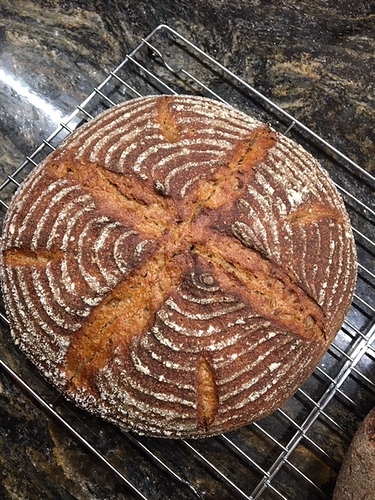First I’d like to thank both Eric for his web site then Melissa and he for their time making recipes and videos to help all of us get started on this venture. I have tried many of Breadtopia’s recipes some were good and some were a failure but in all it was and is a learning experience. Like many have said recipes are only a starting point. I have made Eric’s Artisan Rye and failed twice (starch attack only I did not realize what it was then) and then after some tweaking made a couple of successful loaves. One of my worst bakes involved bulking in my retarder. Zero rise and the dough spent 12 hours at 50F then 12 hrs at 60F and finally 12 hrs at 70F. HAD A BRICK! Since starting this I have probably made 50 loaves of rye using steps from different authors and am finally becoming “a little” more knowledgeable than I was some months ago when I started. I keep reading and finding out more on the subject and yesterday I revisited Eric’s recipe to do some comparisons and read through the comment section from beginning to end. I see that some folks have had good results with his recipe and some not so I thought I would share some info collected. Some of the issues I read in this forum relate to this information. By and large baking with rye reminds me of baking with Einkorn.
“Bran in rye bread actually lightens the dough (opposite of wheat) which is less dense than the “gels” that form in the rye dough. Whole rye turns out to be a better crumb.”
“Rye proteins are weaker than wheat and have a limited ability to form gluten. Rye breads DO NOT depend on gluten to hold them together. Rye contains carbohydrates called arabinoxylans which absorb water and turn into a viscous gel. It is this gel that can be wrecked by overworking or over kneading the dough.”
“Rye contains amylases that transform these carbohydrates into sugars “AKA starch attack”. Gluten in wheat is immune to this degradation. If a rye dough stands for too long at room temperature the amylase breaks down the starchy gels robbing them of their ability to trap gases. To make matters worse this amalase attack SPIKES during the first minutes of baking ending only when the dough reaches 175F. If left unimpeded this attack will turn rye doughs into dense, gummy loaf.”
“The solution to the biological drama is lactic acid producing bacteria or LAB. The affects of the LAB allow the rye doughs to hold their fermentation and baking gases as the amylase activity drops to almost zero. The pH of the dough plays an important part and without it you can have the starch attack.”
“Temperature is different meaning the yeast and LAB peak at 82F and 91F respectively giving an ideal dough temperature of 84F. Note that at typical home refrigerator temperatures both the yeast and LAB become dormant and will continue to die off at these temperatures.”
“Because of rye’s chemistry the vast majority of rye breads start with significant amounts of acidic LAB ingredients like honey, buttermilk, vinegar, yogurt or “wild yeast” culture.”
“Kneading or no kneading requirement: Generally over 50% rye = almost no knead, just return to original shape after bulk, minimal knead should produce structure. Over 60% rye knead not required nor is shaping.”
“A sour dough sponge that contains at least 30% of the total flour will eliminate the requirement of any additional commercial yeast and will produce a well developed crumb with complex flavor.”
“A sour dough culture kept in the refrigerator and fed every few days then refreshed within 36 hours of their last feeding will make good sour dough bread but it will be LAB dominant. IT MAY leaven the bread dough but then IT MAY NOT. It all depends. I have had it work and then it didn’t so what do you do? The only way around this is to use a small amount of commercial yeast in the final dough. This practice is not uncommon and does guarantee the dough will rise if you get the proofing right. Of course you could keep your starter on the counter at room temperature, refresh twice a day and eat lots of sourdough pancakes and Naan, you then can feel assured your starter will leaven the dough.”
“As rye dough is not wheat dough the parameters around proofing are noticeably different. Rye ferments quickly and the dough in itself is unstable. Bulk proofing with a large sour dough culture (LAB dominate) component are somewhat time tolerant with an average time of 1 hour or longer at 72-82F. There are some doughs that will go as long as 5 or 6 hours, just depends on the recipe and your environment. The dough should look smooth textured and will have expanded 1 1/2 to 2 times their original size and have a clean sour smell.”
“Final stage proofing IDEALLY should take place in the range of 85 to 105F although room temperature works just as well just takes longer. Average time for final proofing is 45 minutes but can vary considerably depending on composition of the dough and the bulk fermentation time. Doughs properly proofed will show first sign of broken bubbles on the surface and/or cracks in the dough.”
“Late stages of the final proof need to be watched closely as the dough can very quickly over-proof resulting in a dense, gummy loaf, especially with high percentage loaves (>50% rye)”
“Rye bread’s typical crust structure has a difficult time holding a vertical shape. Not unusual for a panned loaf to rise above the lip of the pan during final proof and then recede to the top of the lip during the bake. Depending on the grains used one with more rye in it will tend to flatten out a bit when freeform baked on a stone. Sides of the dough need support to rise up.”
“For a taller loaf using a pan use a pullman pan which is taller and not as wide.”
Except for the Pullman pan as I don’t have one yet, I have been using the above for a couple of months with no failures, so evidently some of it must be on target. I have yet to delve into using the retarder for cold proofing rye before baking. I know it is done.





 . THEN. I watched the video after it was too late. My first result is unique. Will try recipe again and use the correct folding technique. Will also check it at 10 hours. Also realized I used rye starter. Not the best idea. Still believe traditional s&f isn’t right with this dough.
. THEN. I watched the video after it was too late. My first result is unique. Will try recipe again and use the correct folding technique. Will also check it at 10 hours. Also realized I used rye starter. Not the best idea. Still believe traditional s&f isn’t right with this dough. … and go for the dough look and feel even if you need to add more flour. I’d add a bit more white flour if you think things are too wet. Also, notice that Eric stirs the dough 3 times at 15 minute intervals … akin to s&f. I do a modified s&f with slightly wet hands and a bowl scraper … very gentle, but enough to get the dough to be more like dough. Rye has a tendency to be like cement or thick mud! At any rate, go for the look and feel in the video with however it works for you.
… and go for the dough look and feel even if you need to add more flour. I’d add a bit more white flour if you think things are too wet. Also, notice that Eric stirs the dough 3 times at 15 minute intervals … akin to s&f. I do a modified s&f with slightly wet hands and a bowl scraper … very gentle, but enough to get the dough to be more like dough. Rye has a tendency to be like cement or thick mud! At any rate, go for the look and feel in the video with however it works for you.